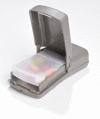Real-time adherence monitoring for HIV antiretroviral therapy
- PMID: 20809380
- PMCID: PMC2974938
- DOI: 10.1007/s10461-010-9799-4
Real-time adherence monitoring for HIV antiretroviral therapy
Abstract
Current adherence assessments typically detect missed doses long after they occur. Real-time, wireless monitoring strategies for antiretroviral therapy may provide novel opportunities to proactively prevent virologic rebound and treatment failure. Wisepill, a wireless pill container that transmits a cellular signal when opened, was pilot tested in ten Ugandan individuals for 6 months. Adherence levels measured by Wisepill, unannounced pill counts, and self-report were compared with each other, prior standard electronic monitoring, and HIV RNA. Wisepill data was initially limited by battery life and signal transmission interruptions. Following device improvements, continuous data was achieved with median (interquartile range) adherence levels of 93% (87-97%) by Wisepill, 100% (99-100%) by unannounced pill count, 100% (100-100%) by self-report, and 92% (79-98%) by prior standard electronic monitoring. Four individuals developed transient, low-level viremia. After overcoming technical challenges, real-time adherence monitoring is feasible for resource-limited settings and may detect suboptimal adherence prior to viral rebound.
Figures



References
-
- Walji MF, Coker O, Valenza JA, et al. A persuasive toothbrush to enhance oral hygiene adherence. AMIA Annu Symp Proc. 2008; 1167. - PubMed
Publication types
MeSH terms
Grants and funding
LinkOut - more resources
Full Text Sources
Medical

